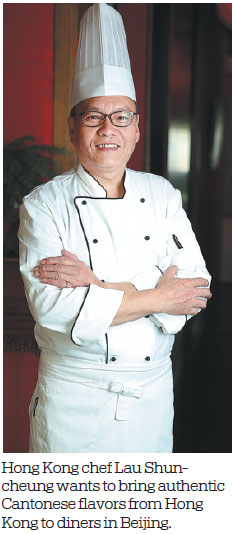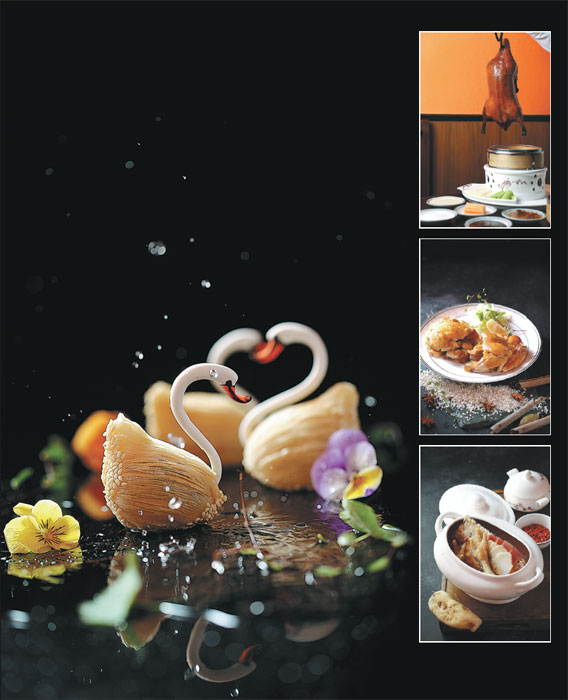Fresh start, just desserts
A classic Cantonese eatery and firm favorite with Beijing gourmets, Xin Ming Yuen is marking its move to a swish new venue with a modernized menu, Li Yingxue reports.
Xin Ming Yuen has been a firm fixture of Beijing's dining circuit for over a decade. The restaurant is making a fresh start this month with new premises, new decor and a brand-new menu.
After six months of preparation, the new eatery on the first floor of Parkview Green has opened its doors to customers with an innovative new interior that combines aspects of traditional Chinese architecture with a range of diverse cultural elements from centuries of Chinese history.
|
Clockwise from main picture: Deep-fried swan-turnip pastry, Peking roast duck, rock-salt baked chicken and double-boiled grouper soup are the highlights of Xin Ming Yuen restaurant in Beijing. Photos Provided to China Daily |
With peacock green and bright yellow as its base colors, the restaurant was designed to be an artistic dining space that combines classic Chinese style with the modern, according to the restaurant's general manager, Edmund Chan.
"The restaurant aims to offer authentic Hong Kong flavors to diners in the capital," says Chan.
"After operating for 11 years, we recognized the fact that the majority of our diners are from northern China, and they enjoy stronger, heavier flavors. We didn't want to change the flavor of our Cantonese specialties, so we added some new dishes from Sichuan, Beijing and Huaiyang cuisines," he says.
One example is Peking roast duck, a creation perfected by chef Zhao Chenggui during his time in Hong Kong.
When he was working in Hong Kong several years ago, his Peking duck became a favorite with celebrity actors like Jackie Chan, Andy Lau and Tony Leung.
The 40-year-old started to learn how to make the famous dish 20 years ago.
"There are three steps to make Peking duck - cleaning, roasting and slicing - and each one takes several years to master," says Zhao.
To perfect his skills, Zhao worked in several Peking-duck restaurants to learn all the variations.
For Xin Ming Yuen, Zhao has condensed his two decades of experience into his own version of Peking duck and has designed his own oven in the kitchen.
"To select the species of duck is the first challenge. In the past, I used 32-to 38-day-old ducks, but now I choose ones around 28 days old that weigh about 2.5 kilograms from a farm in Beijing's suburbs," says Zhao. "This is because a duck of this size has the best balance between the fat under its skin and the moisture of its meat."

The duck has to go through several steps in the two days before it's served. It's cleaned 12 hours after it's defrosted and left to dry for hours before it's ready to be cooked. Each duck is brushed with a special sauce to make the skin shiny and crisp before it's oven-roasted for 75 minutes.
Zhao has created a soup base he pours in the duck breast before the roasting process to prevent the meat from drying out. "I add wolfberries and Chinese dates to the broth, which are good for health but don't override the ducks' flavors," says Zhao.
The duck is sliced into between 88 and 100 pieces and divided across three plates - one containing pure skin, one with breast meat, and one that combines skin and leg meat.
"If there is no fat left between the skin and the meat, and the skin melts in your mouth, the duck is cooked perfectly," says Zhao.
The chef has also prepared two sauces for the duck - one is a steamed-and-fermented flour sauce, while the other is a garlic sauce with sugar and sesame oil.
Presentation is also important to Zhao, who likes to slice the duck for his diners and show them how to best savor its flavors.
"The skin should be dipped in sugar, and the breast should be eaten with the special fermented-flour sauce, while the meat from the duck leg with the skin on should be combined with the garlic sauce, slices of cucumber and scallion, and wrapped in the lotus-leaf shaped pancake," says Zhao.
"We strongly recommend our diners finish the duck within 5 to 10 minutes after we serve it. Otherwise, the duck will get cold and lose its delicious flavor," he says.
Executive chef Lau Shuncheung also brings his 30 years of Cantonese-cooking experience to the table, presenting his signature rock-salt baked chicken and deep-fried crispy chicken from Hong Kong to the capital.
Both dishes use a breed of chicken from Guangdong province that has to be dried for four hours before it's cooked.
"Unlike traditional deep-fried chicken, where the whole bird is fried in oil, I hang the chicken up and pour hot oil over the carcass for 20 minutes to ensure the meat crisps evenly," says Lau.
This dish has to be preordered a day in advance. Lau completes 90 percent of the process before setting the chicken aside for a few hours to dry out before the diners arrive. He finishes cooking it just before it is served.
Grouper is another key ingredient for Lau. He uses different parts of the fish to make several dishes - the spine is braised in gravy, while the filets are cooked in fish bouillon or chili soups.
"Each part of the fish needs a separate cooking method to make its flavor shine, and the cooking times also vary," says Lau.
Lau thinks the key to Cantonese cuisine is to keep the original flavors of the fresh ingredients.
His wok-fried abalone with scallions proves his skills in Cantonese cooking as it only takes two minutes to make - the fresh abalone is pan-fried for just a minute before scallions are added and fried along with it over a high heat for a minute more.
"When the abalone starts to curl, it means it's ready and you need to plate it straight away. The key is you have to keep watching it and turn off the heat at the right moment," he says.
According to Lau, the deep-fried swan-turnip pastry and the ground-almond cream with egg white are the two must-try traditional Cantonese desserts at the restaurant.
"I stick to the same flavors as I cook in Hong Kong with all my dishes, no matter where my diners come from," says Lau.
Contact the writer at liyingxue@chinadaily.com.cn
(China Daily Global 08/23/2019 page15)



















